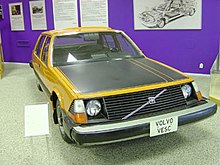Experimental safety vehicle
Appearance
Experimental safety vehicle (ESV) is the designation for experimental concept cars which are used to test car safety ideas.
In 1973, the U.S. DOT announced its ESV project, the aim of which was to obtain safer vehicles by 1981.[1] A car produced by this effort was known as the Minicar RSV.
In 1991, the ESV abbreviation was backronymed to enhanced safety of vehicles.[2]
Some ESVs
[edit]- Aurora, a one-man effort 1957 ESV
- Sir Vival, a safety car created by Walter C. Jerome in 1958 ESV.
- Austin Metro PSC1 (Pedestrian Safety Car One), 1985[3]

Mini SRV4 (1974) - SSV1 based on the MGB GT (1972)
- SRV2 based on the Morris Marina (1974)
- SRV3 based on the BMC ADO 17 Austin 1800 badge engineered family
- SRV4 based on the Mini
- SRV5 based on the BMC ADO 16 Austin/Morris 1300, featuring an innovative spring-loaded pedestrian-catching bar
- Chrysler RSV – Research Safety Vehicle – based on the Simca 1307[5]
- Datsun ESV (1973), based on the Nissan Bluebird[6]
- Fairchild Republic ESV (1973)
- Fiat ESVs 1500 libbre, 2000 libbre and 2500 libbre (libbre meaning 'pounds' in Italian) (1971)[7][8]

Mercedes-Benz ESF22 (1973) 
Mercedes-Benz ESF 2009 Experimental Safety Vehicle - Nissan 216X (1971)[11]
- Pininfarina PF Sigma (1963)[12]
- Pininfarina Sigma (1969), a Ferrari-based Formula One ESV[13]
- Pininfarina Nido (2004), featuring a sled-mounted survival cell with interior crumple zones
- Renault BRV – Basic Research Vehicle – (1974)
- Renault Epure, based on the Renault 5 (1979)

Toyota ESV (1973) 
Volvo VESC (1972) - Volvo SCC (2001)
- Volkswagen ESVW1 (1972)
References
[edit]- ^ "20th Enhanced Safety of Vehicles Conference, Innovations for Safety: Opportunities and Challenges". Archived from the original on 2006-09-22. Retrieved 2006-12-03.
- ^ "20th Enhanced Safety of Vehicles Conference". Archived from the original on 2007-02-10. Retrieved 2007-02-17.
- ^ AROnline: Made in Britain Archived 2007-10-08 at the Wayback Machine
- ^ AROnline: Made in Britain Archived October 8, 2007, at the Wayback Machine
- ^ RSV development
- ^ Archive index at the Wayback Machine
- ^ Gallery Archived 2010-10-14 at the Wayback Machine
- ^ Internet Archive Wayback Machine
- ^ Mercedes Safety Research Test Lab on Wheels
- ^ The ESF 2009 Experimental Safety Vehicle Archived 2012-12-05 at the Wayback Machine
- ^ Internet Archive Wayback Machine
- ^ Internet Archive Wayback Machine
- ^ "Pininfarina Sigma, designed by Paolo Martin".
External links
[edit]- NHTSA Page of ESV Conference Proceedings, 1998 (16th) to (as of 2016[update]) 2015 (24th)
- Collection of technical PDFs about ESVs including Proceedings from several older ESV Conferences.





